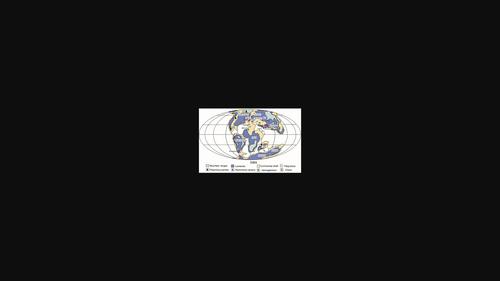当前位置:
X-MOL 学术
›
Geolog. J.
›
论文详情
Our official English website, www.x-mol.net, welcomes your
feedback! (Note: you will need to create a separate account there.)
Charophytes from the Cretaceous–Palaeogene transition in the Jhilmili intertrappean beds of Central India
Geological Journal ( IF 1.4 ) Pub Date : 2022-07-27 , DOI: 10.1002/gj.4528 Ashu Khosla 1 , Sachin Kania 1 , Spencer G. Lucas 2 , Omkar Verma 3
Geological Journal ( IF 1.4 ) Pub Date : 2022-07-27 , DOI: 10.1002/gj.4528 Ashu Khosla 1 , Sachin Kania 1 , Spencer G. Lucas 2 , Omkar Verma 3
Affiliation

|
The Jhilmili intertrappean beds (Chhindwara District, Madhya Pradesh) of Central India are studied from a palaeoenvironmental, palaeoecological, and palaeobiogeographical perspective using fossil charophytes. These beds have yielded a diverse charophyte assemblage, consisting of Platychara perlata, Platychara raoi, Platychara sahnii, Peckichara cf. varians, Nemegtichara cf. grambasti, and Chara sp. 1. These charophytes were recovered from a 60 cm thick clayey and nodular limestone unit that is underlain by claystone and overlain by laminated claystones deposited on fluvial floodplains. This charophyte assemblage suggests a Late Cretaceous–Early Danian age, which agrees with the previous dating carried out using freshwater to brackish water ostracods and planktic foraminifera found in the same beds, together with dasycladalean and halimedacean chlorophytes. The Jhilmili intertrappean charophyte assemblage resembles those found in other infra-and intertrappean sections of western, central, and southern India. The charophyte assemblage indicates that during the Cretaceous–Palaeogene timespan the Indian subcontinent mainly experienced interchange with Laurasia (China, Europe, and North America) but also with Gondwana (North Africa and South America). In the opposite sense, Laurasian species might have dispersed to India by means of a sweepstakes route across the Kohistan–Dras volcanic arcs.
中文翻译:

印度中部 Jhilmili 阶间层白垩纪 - 古近纪过渡的轮藻
使用化石轮生植物从古环境、古生态和古生物地理的角度研究了印度中部的 Jhilmili intertrappean 床(中央邦 Chhindwara 区)。这些床产生了多样化的轮藻组合,包括Platychara perlata、Platychara raoi、Platychara sahnii、Peckichara cf。瓦里安,Nemegtichara cf。格兰巴斯蒂和查拉sp。1. 这些轮生植物是从一个 60 厘米厚的粘土和结节状石灰岩单元中回收的,该单元下面是粘土岩,上面是沉积在河流漫滩上的层状粘土岩。这种轮藻组合暗示了一个晚白垩纪 - 早大纪元时代,这与之前使用淡水到微咸水介形虫和浮游有孔虫在同一床层中发现的年代进行的测年一致,以及 dasycladalean 和 halimedacean 叶绿体。Jhilmili intertrappean 轮藻组合类似于在印度西部、中部和南部的其他下层和 intertrappean 部分发现的组合。轮藻组合表明,在白垩纪—古近纪时期,印度次大陆主要与劳亚大陆(中国、欧洲、和北美)以及冈瓦纳(北非和南美)。在相反的意义上,劳亚物种可能通过穿越科希斯坦-德拉斯火山弧的抽奖路线散布到印度。
更新日期:2022-07-27
中文翻译:

印度中部 Jhilmili 阶间层白垩纪 - 古近纪过渡的轮藻
使用化石轮生植物从古环境、古生态和古生物地理的角度研究了印度中部的 Jhilmili intertrappean 床(中央邦 Chhindwara 区)。这些床产生了多样化的轮藻组合,包括Platychara perlata、Platychara raoi、Platychara sahnii、Peckichara cf。瓦里安,Nemegtichara cf。格兰巴斯蒂和查拉sp。1. 这些轮生植物是从一个 60 厘米厚的粘土和结节状石灰岩单元中回收的,该单元下面是粘土岩,上面是沉积在河流漫滩上的层状粘土岩。这种轮藻组合暗示了一个晚白垩纪 - 早大纪元时代,这与之前使用淡水到微咸水介形虫和浮游有孔虫在同一床层中发现的年代进行的测年一致,以及 dasycladalean 和 halimedacean 叶绿体。Jhilmili intertrappean 轮藻组合类似于在印度西部、中部和南部的其他下层和 intertrappean 部分发现的组合。轮藻组合表明,在白垩纪—古近纪时期,印度次大陆主要与劳亚大陆(中国、欧洲、和北美)以及冈瓦纳(北非和南美)。在相反的意义上,劳亚物种可能通过穿越科希斯坦-德拉斯火山弧的抽奖路线散布到印度。











































 京公网安备 11010802027423号
京公网安备 11010802027423号